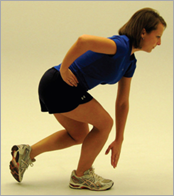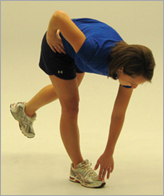In a past article, I discussed assessing and treating dysfunction of the gluteus medius. I reviewed an article from the Journal of Strength and Conditioning Research and the author’s recommendations. Taking this information one step further, a recent article in JOSPT has quantified electromyographic activity of the gluteus maximus and gluteus medius during common exercises. This information is helpful when deciding which exercises to perform in your patients or clients.
Based on the results of this study, we can identify exercises that produce the highest amount of EMG activity.
Gluteus Medius
 Side-lying hip abduction – 81%
Side-lying hip abduction – 81%- Single limb squat – 64%
- Lateral band walk – 61%
- Single-limb deadlift – 58%



Gluteus Maximus
- Single-limb squat – 59%
- Single-limb deadlift – 59%
- Sideways, front, and transverse lunges – 41-49%
In addition to the manuscript, there are good video demonstrations of the exercises and a PowerPoint presentation available at the JOSPT website. When I accessed this, I believe they were all available for free.
Clinical Implications
Based on the results of this article, here are a few things that came to my mind
- Side-lying hip abduction should be used in all people needing glut medius strengthening. EMG activity was almost 20% higher than the next exercise.
- The single limb squat and single-limb deadlift exercises activated high amounts of EMG activity for both muscles
The clam exercises produced EMG activity between 34-40% for both muscles. While this is low in comparison to other exercises, the authors did not use resistance during testing. I would still use this, especially with a resistance band around the thighs, as am early-stage or activation exercise. The authors also compared clams at 30 degrees and 60 degrees of knee flexion and showed no different in gluteus medius activity.
- The lunge exercises produce a moderate amount of EMG activity and are likely good early-stage exercises to progress to prior to the single-leg squat and deadlift exercises
DiStefano, L. (2009). Gluteal Muscle Activation During Common Therapeutic Exercises Journal of Orthopaedic and Sports Physical Therapy DOI: 10.2519/jospt.2009.2796
Want to learn more about how to get the most out of the hips and glutes? I have two great inner circle webinars on My Top 5 Tweaks to Enhance Hip Exercises and How Pelvic Position Influences Lower Extremity Stretching. Click here to learn more about my Inner Circle and how you can gain access to these webinars and more for only $5.






